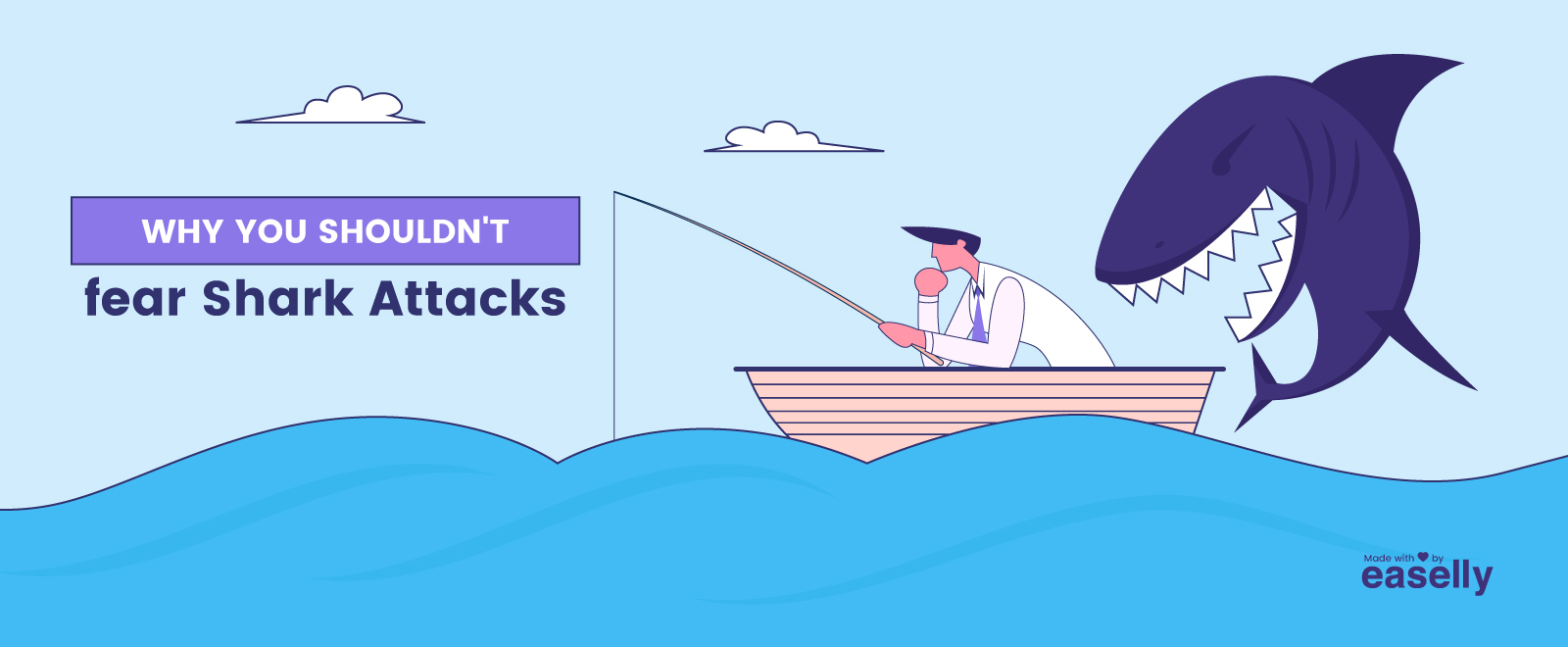Shark Attack Infographics: Why you don’t need to be afraid of Shark Attacks.
There’s a primal fear hardwired into our brains surrounding large open bodies of water. Sharks inspire equal parts awe and dread in us today and as a species we have a long and troubled relationship with these majestic creatures. If you’ve ever swam in open water you’ll know the fear we’re talking about well. At any instant you’re expecting to feel something snatch you with force like some poor seal on shark week. However we thought that the time was ripe to dispel some of the myths surrounding sharks. With some shark attack Infographics, let’s go through the statistics! Hopefully by the end of this you’ll see we don’t have anything to fear from sharks.
Well. Not much to fear. Don’t go poking one or swimming late at night covered in bacon!
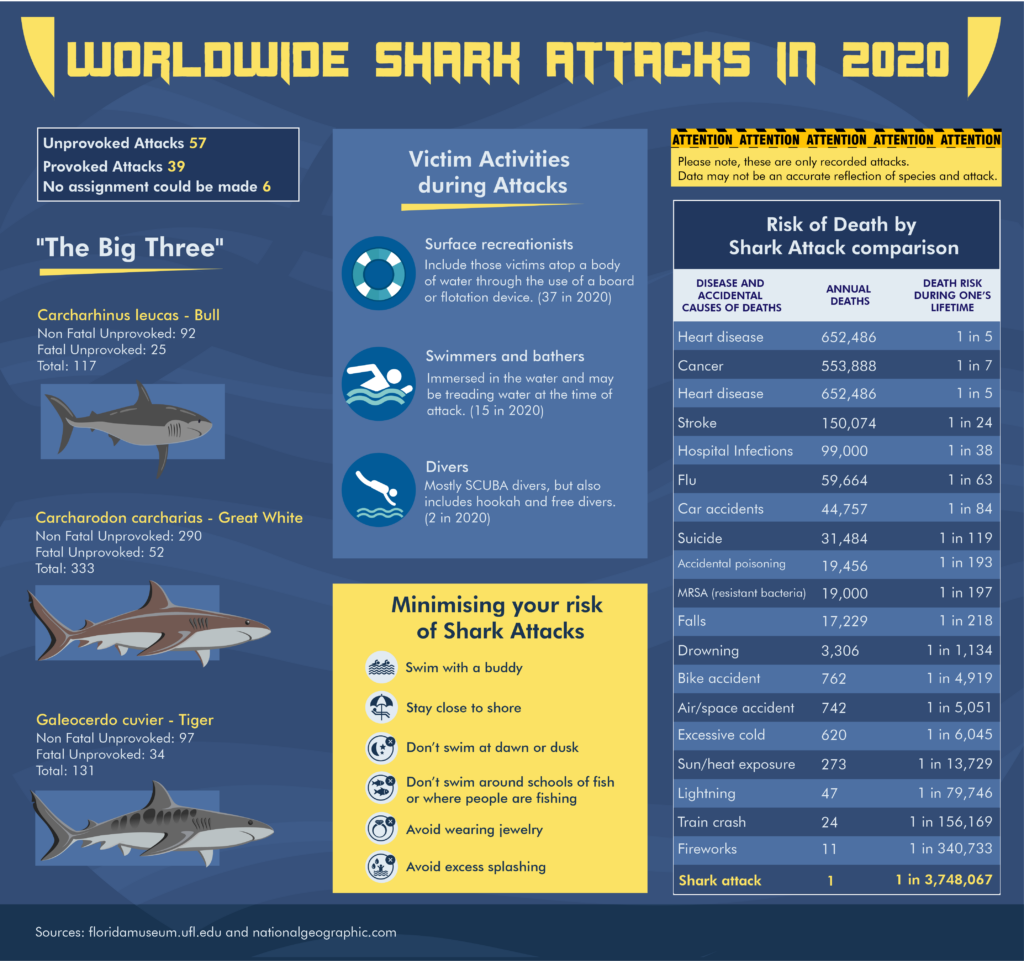
Shark Attacks in 2020
Many of us feel uneasy looking at sharks. However unless you’re a seal, in which case well done for reading this, you statistically don’t have much to fear from these creatures. We’ve heard all the “reassuring” stats before and, if you’re like us, they failed to reassure. Well what if you could see a shark infographic or two that would help ease your mind by visualising just why you shouldn’t be afraid of sharks?
The inspiration for this blog came from news reports circling regarding a video of a child in Hawaii having a close encounter with a shark whilst playing close to shore. A truly terrifying experience to be sure but the question has been asked, was the child truly in danger?
Experts believe that the shark, a black-tip reef shark, was actually chasing fish and was not targeting the child. Obviously this does nothing to assuage the fears of the child and the public and this is completely understandable. But it can’t be avoided, it’s launched sharks back into the forefront of people’s minds and it is important to realise that you don’t have anything to fear realistically.
Species of Shark Involved in attacks
Out of more than 400 species of Shark, there are only 3 responsible for fatal attacks in the double digits. It’s important to note that this is only the recorded attacks. For example if we look at shipwrecks and disappearances at sea over the centuries we have no idea how many people may have been killed by sharks or sea creatures of unknown origins. However, of the sharks we know about there are 3 main “offenders.”
The Great White, the tiger shark and the bull shark. Statistically speaking the Great White is the most dangerous of the three, and it is without a doubt the most famous. Since we started keeping records the great white has been responsible for 326 unprovoked attacks. The tiger shark comes in at 129 and the bull shark at 116.
If you live in an area where these sharks don’t roam, your chances of being attacked drop astronomically. This leads us right on to the specifics of geography. Check out the shark attack infographics or the text below.
Geography of Shark Attacks
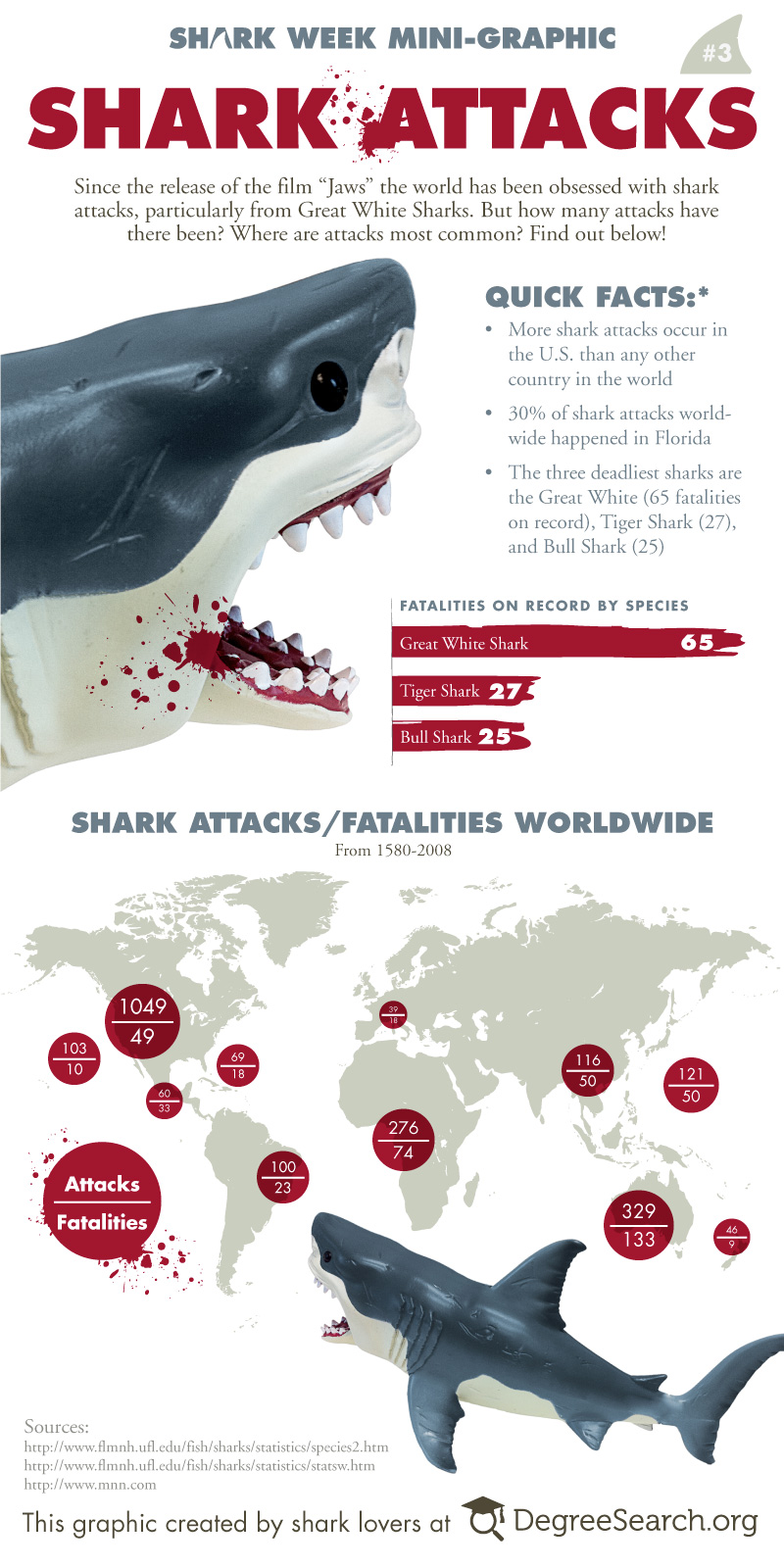
Geography is a huge factor when talking about probabilities of shark attacks. You’re far more likely to get attacked if you live on a pacific island compared to if you live in a landlocked village.
So if you live in any of the countries in the bottom half of the map then you really shouldn’t be overly worried about encountering one of these toothy creatures. That’s not to say you should be scared if you’re living in America. Just because it is high on the list of countries, doesn’t mean you should be running for the hills. In the United States, your chances of being attacked by a shark are about one in 5 Million. In fact you have more chance of being killed by the following bizarre occurrences! Check out our shark attack infographics for some more information!
- Getting crushed by a falling Vending Machine
- Being Killed by a flying Champagne Cork
- Death by stampeding Donkeys
- Being struck by Lightning!
So if you live in America, and you don’t want to go to the beach due to fear of sharks, now you know! You should be more afraid of the sky, donkeys and champagne at cocktail parties.
Causes of Shark Attacks
Shark attacks are not for food. Not usually. It’s surprising as humans logically would be an ideal prey for sharks. We’re slow and ungainly in the water relatively, we have no real protection or natural defences to deter the sharks. However thankfully the human body is quite foreign to these armoured, teethy fish. We’re alien to their home and thankfully, sharks just aren’t that interested in us.
Gavin Naylor, director of the Florida Program for Shark Research sums it up quite nicely.
“We are like helpless little sausages floating around in the water. But despite being potentially such an easy meal, sharks are really not that interested in hunting humans. “They generally just ignore people. I think if people knew how frequently they were in water with sharks, they would probably be surprised.”
If this is the case, then what are the causes of shark attacks? Whilst it is important to realise that we don’t know everything, researchers have come up with some fairly solid theories on the matter.
In shallower waters attacks tend to be from blacktip or spinner sharks. These sharks are hardwired to attack anything they might perceive as prey, usually the flash of a fish or eel. To these sharks a flash of a foot sole or an untanned bather can oftentimes trigger their attacking instinct. In this instance the shark will lash out, bite and then quickly retreat.
However fatal attacks from the big three (bull sharks, tiger sharks and great whites) require different explanations.
With bull sharks the prevailing explanation seems to be their hunting habitats. Bull sharks can survive in freshwater and so they often hunt in and around tidal estuaries and river mouths. These waters are often murky and can lead to attacks from confusion.
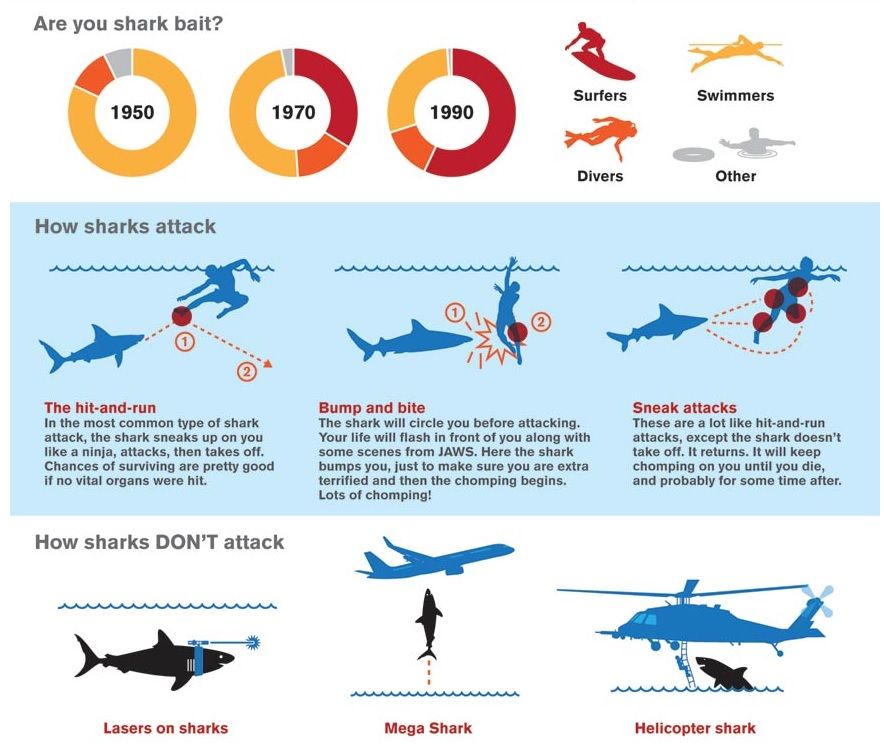
As for the great whites, curiosity seems to be the cause. Great whites hold a special place in our fears, largely due to Steven Spielberg’s 1975 classic Jaws. However survivors of great white attacks shed some light on the causes of these attacks. If you’ve ever seen a great white on shark week, you’ll know that it’s preferred mode of hunting is to attack at speed from below, often breaching fully out of the water. With attacks on humans this doesn’t seem to be the sharks m.o.
As we learn more about great whites it’s starting to become clear that the shark is actually nibbling a foreign body to check if it’s a suitable food source or not. Most often it bites, then retreats. Their mouths function as finely tuned sensory organs, leading sharks to “mouth” unfamiliar objects as a means of examining them and determining their possible food value. After all, they don’t have hands!
Part of what makes the shark the top of its food chain is their territorial nature. Finely honed by evolution a shark instinctively defends its food source from any and all comers. As human beings expand further and further we enter those territories and the shark, quite rightly, sees us as a threat and attacks.
So there you have it, the three main causes of shark attacks:
- Mistaken Identity
- Curiosity
- Territory “disputes”
Our shark attack infographics will expand more. What is clearest here is the shark has much more reason to be wary of us than we do of it. In 2020 the International Shark Attack File reported only 57 unprovoked shark attacks all over the world. In contrast we kill around 100 million sharks every year as a species. So who’s the real villain here?
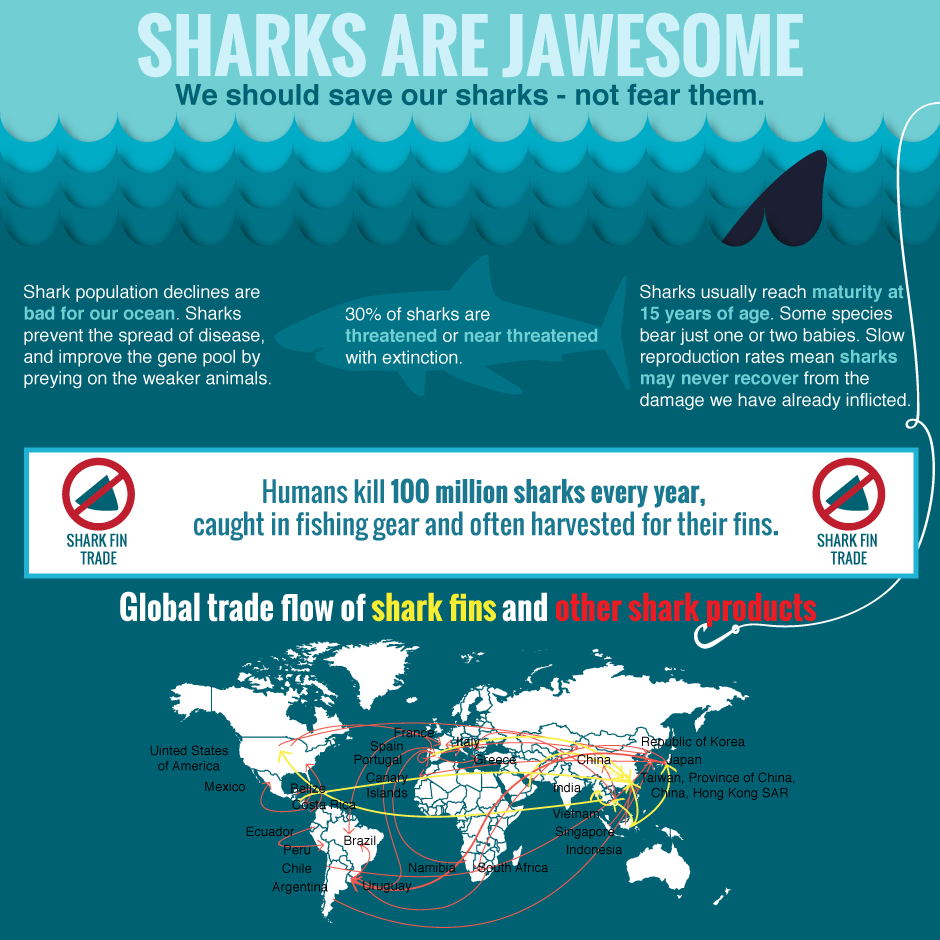
Shark Attack Infographics: Avoiding Shark Attacks
If you still aren’t convinced by the ridiculous odds, then there are things you can do to avoid a fatal shark encounter. Keep in mind that chances are good you’ve swam close to sharks in the past, with no negative consequences for you or the shark.
- Pay attention to areas with known populations of sharks. River mouths, deep water features etc. are known hunting grounds. Check online or with local authorities if you’re in an area known for shark attacks.
- if possible avoid going in the water during low light. Dawn and sunset are the preferred feeding times for many species and the lack of light can lead to mistaken identity.
- Don’t go in the water in areas with lots of seals and sea lions
- If you’re bleeding, don’t go in the water.
- Don’t ignore signs, warnings and common sense!
If you follow these guidelines your chances of a deadly encounter with a shark are ridiculously low.
Let’s have a look into our history with sharks and where our fear of the creatures comes from
Shark Infographic: Sharks and Early Human Societies
Human beings are at the top of the food chain right now. The problem is that we didn’t exactly earn our place at the head of the table. At least not in an evolutionary sense. Human beings have cheated their way to the top by using our brains. We’re not particularly fast, strong or agile but with our superior brains we’ve managed to make our way up the food chain in a frankly lightning quick timescale.
Sharks are different. These animals are in the upper echelons of their food chain and for very good reason. These natural born killing machines have gone through 100 Million years of evolution. Developing killer instincts, an array of weapons and a bit of a nasty attitude, these murder fish are not to be trifled with. That’s why for as long as humans have been on the planet (a mere 6 million years or so in comparison,) we’ve known instinctively to be wary of the water.
For coastal and Island cultures from Polynesia to the Yukon, sharks are a vital part of their heritage and mythology. Sharks are often revered as much as feared, and feature prominently in these cultures’ creation myths. However, although these legends were often positive in nature, we’ve always respected and feared these creatures. As humanity developed and began to expand and explore the planet our reverence dwindled and the fear increased.
Sharks and Seafaring
As we began to traverse the world’s oceans with growing ability and confidence, sharks became much more real. Although they were once the stuff of legend, more and more people could talk about encountering the creatures.
As our interactions with sharks increased, fascination became terror. Early sailors and whalers hated sharks with a burning passion. Although not exactly environmentalists, these early seafarers inflicted special cruelties on sharks. Especially for those in the whaling industry, familiarity with sharks bred contempt.
Often whilst cutting up their quarry, whalemen would be suspended on thin railings jutting out from the boat. Mere feet below would be a churning mass of sharks, blood and viscera. Imagine staring down at that mass of fins, teeth and matter. All of this whilst balancing on a plank extended from a ship on a rolling sea. No doubt this was a living nightmare for most who experienced it and we know from their journals they exacted some cruel punishments on any sharks they may have caught. It’s also important to remember that survivors from shipwrecks would be fair game for the sharks!
As these sailors and whalers returned to shore they brought tales of horrifying man eaters and nightmare scenarios home. Many of those hearing the stories had no personal experience with sharks themselves and so the tales and legends grew. Our fear of sharks was thoroughly cemented.
In the early 20th century trips to the seaside became a national pastime in the US and other countries. With this development we got up close and personal with sharks far more often. With our new familiarity with the ocean’s apex predator came more fear. In 1916 4 people were killed in a span of 2 weeks in New Jersey by sharks. Following these events, sharks became synonymous with panic and fear.
USS Indianapolis: The Most Famous Shark Attack in History
The chaotic 20th century was a real flashpoint for human relations with sharks. However no shark attack holds the same amount of horror as the sinking of the USS Indianapolis.
The Indianapolis was an American heavy cruiser in the second World War. In 1945 it undertook a secret mission to deliver components of the first atomic bomb dropped on Japan. After the successful completion of this mission, all hell broke loose.
As the ship returned from it’s mission it was struck side on by japanese torpedoes and sank. Following the sinking 300 sailors went down with the ship. Roughly 900 men went into the water and faced a horrifying 4 day ordeal.
Although dehydration and salt water poisoning killed their fair share of men, many fell victim to sharks. Only 316 men survived and the incident to this day is one of the most horrifying stories of World War 2. The story of the Indianapolis was immortalised in Steven Spielberg’s Jaws. Robert Shaw’s character in the film is a survivor of the Indianapolis turned shark hunter and relays the story to his new shipmates. See the clip below and read more on the topic if you dare!
Conclusion: Don’t be afraid of shark attacks!
Hopefully these shark attack infographics and writings have eased your mind a little. Sharks are so much more than vicious killers. They’re complicated creatures deserving of our respect and protection! Read a little more on our endangered animals blog to learn about how to protect our wildlife. If you like any of the infographics we’ve made up for this or any other blog why not make one yourself? Or let us know and we’ll make one for you!
A fear of sharks is a common phobia. However it may surprise you to know that it shouldn’t be! Click here for our shark attack infographics for more info
